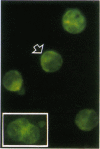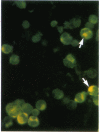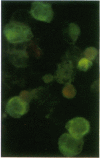Abstract
A rapid, sensitive indirect immunofluorescence assay has been developed for detection of antibodies to the acquired immune deficiency syndrome (AIDS)-associated retrovirus (ARV). The human T-cell line HUT-78 was chronically infected with ARV-2 and used to detect antibodies to virus-specific cytoplasmic antigens. Because the helper T-cell marker Leu-3 is substantially reduced in this cell line after ARV infection, it appears to be an important receptor for virus infection. Nearly all patients with AIDS and most cases with related conditions showed antibodies against ARV. Some healthy individuals in risk groups for developing AIDS also had antibodies to the agent. In contrast, no antibodies to the virus were found in any individuals outside the risk groups for developing AIDS or with diseases other than those associated with AIDS. The titers of antibodies to ARV and to Epstein-Barr virus varied independently from each other. The level of anti-ARV antibodies in a patient's serum was found to reflect the severity of the disease; it was lower in individuals with more severe manifestations. Taken together, these data support the role of ARV in AIDS and its related disorders.
Full text
PDF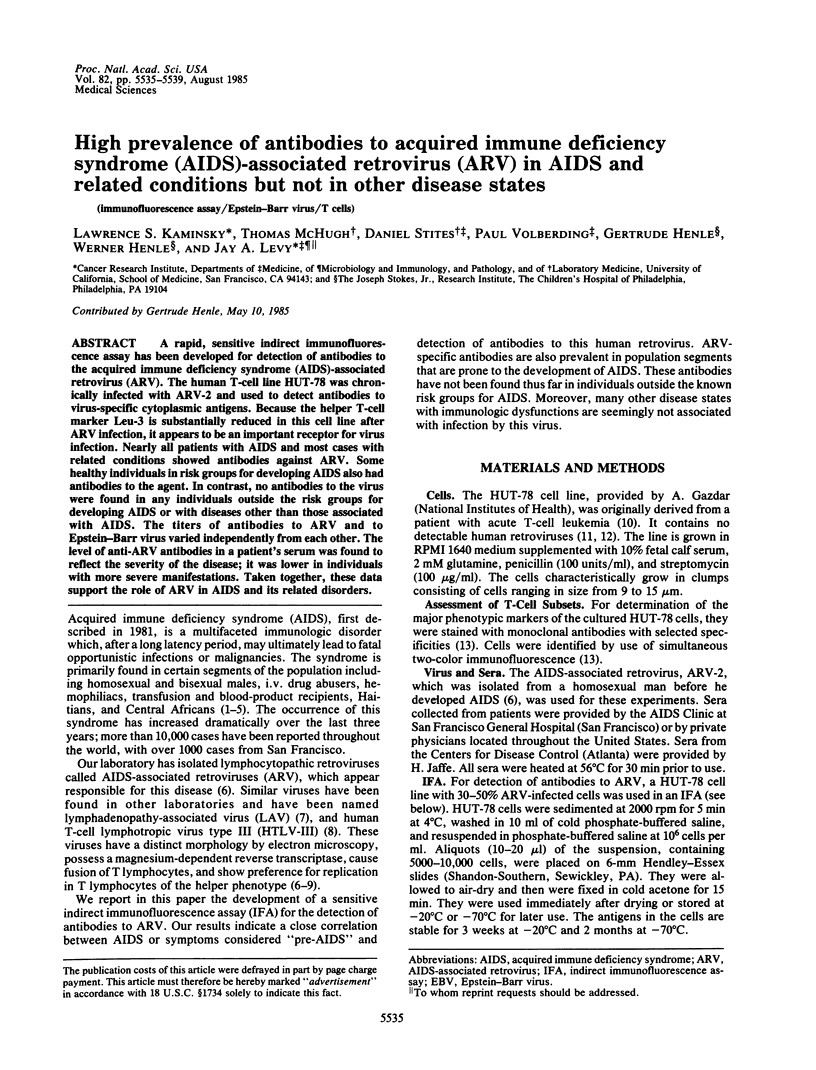
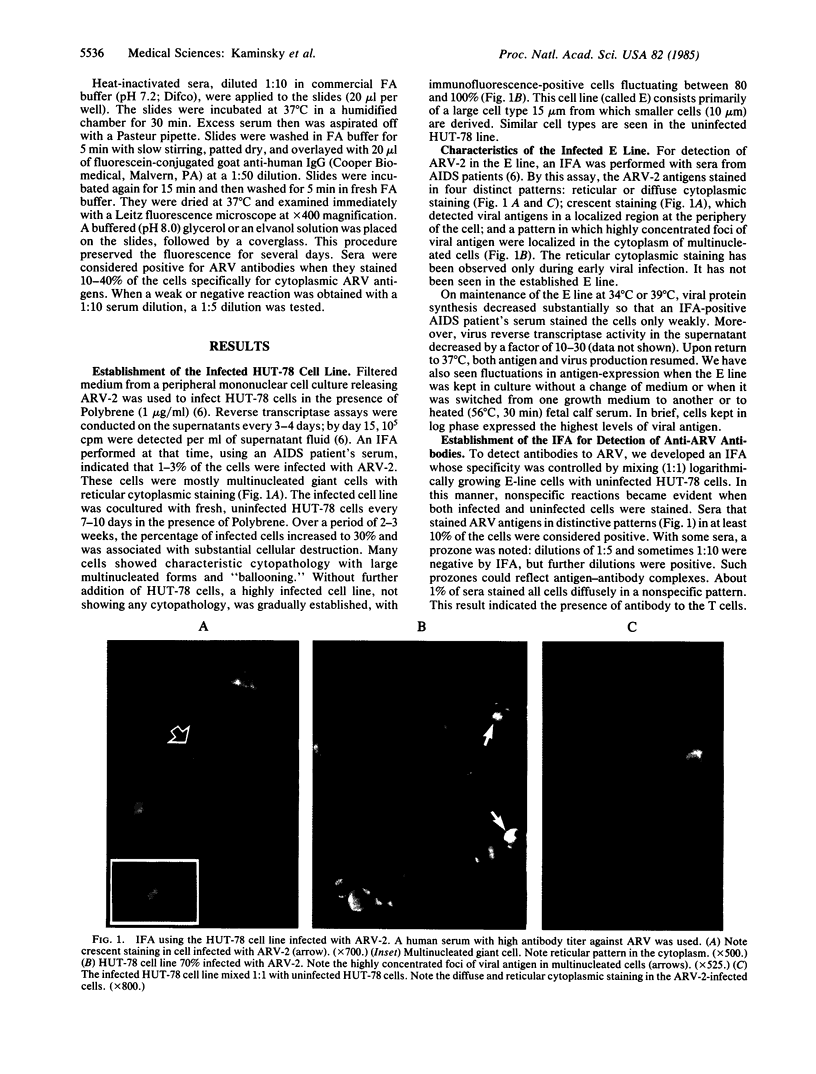
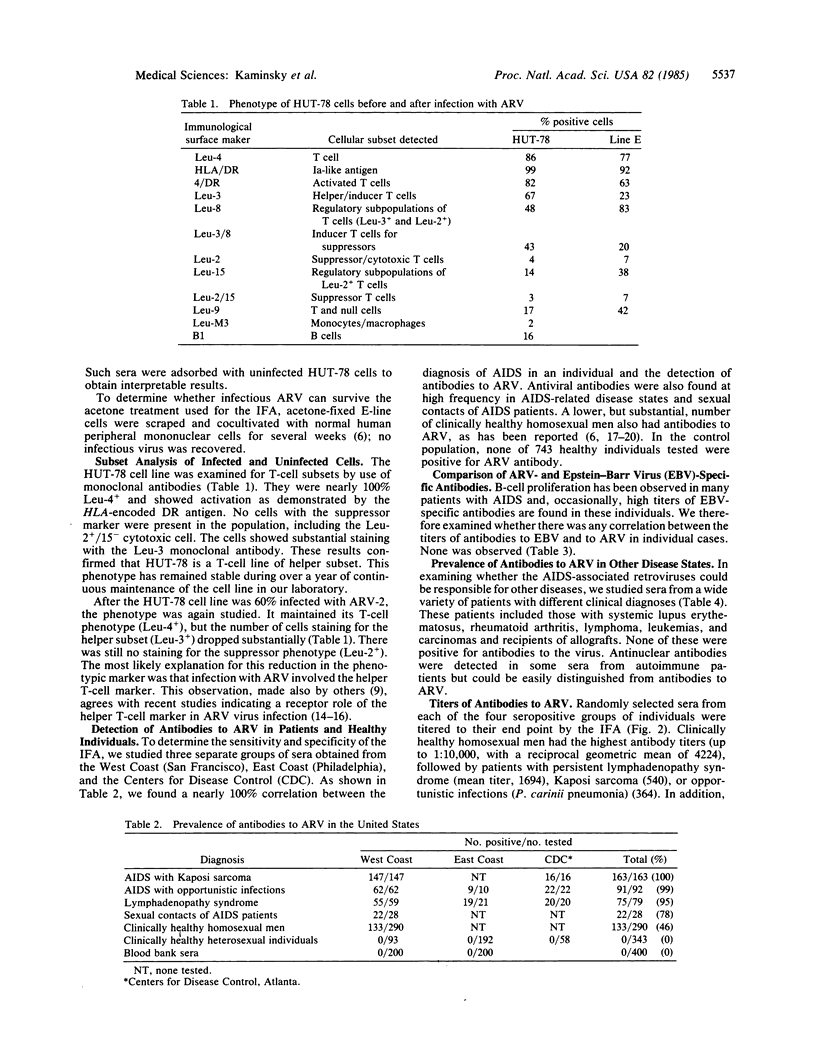
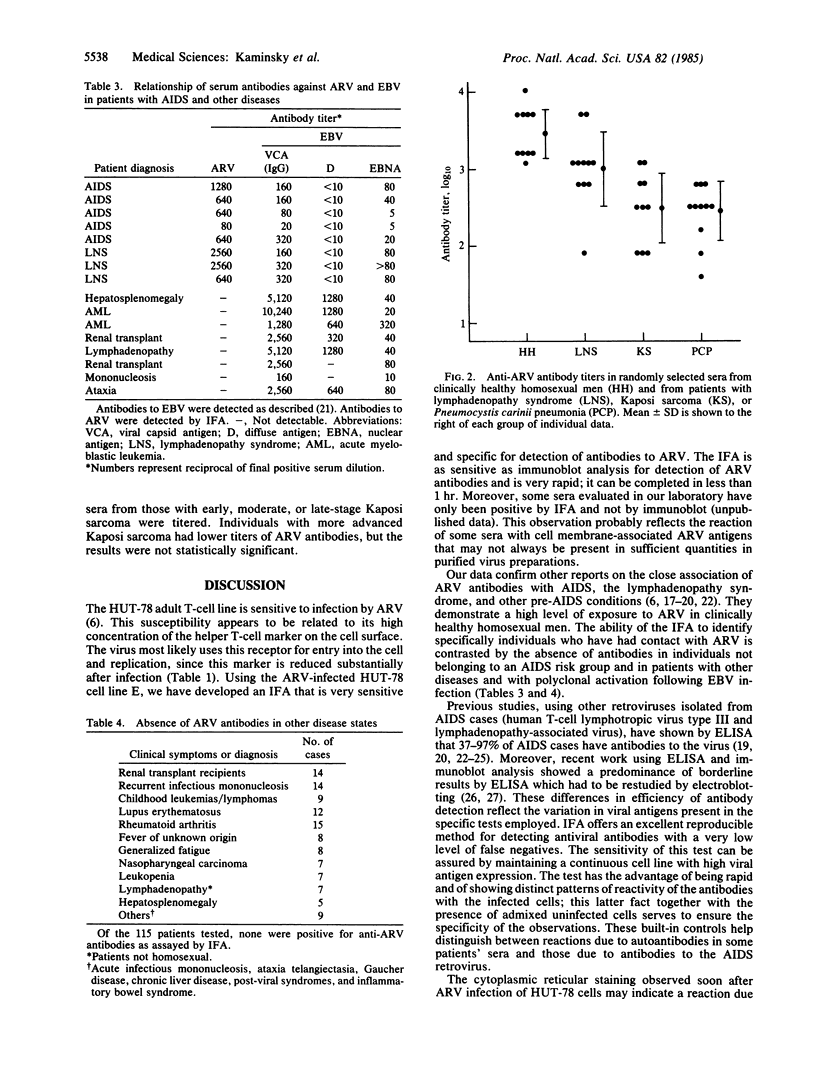
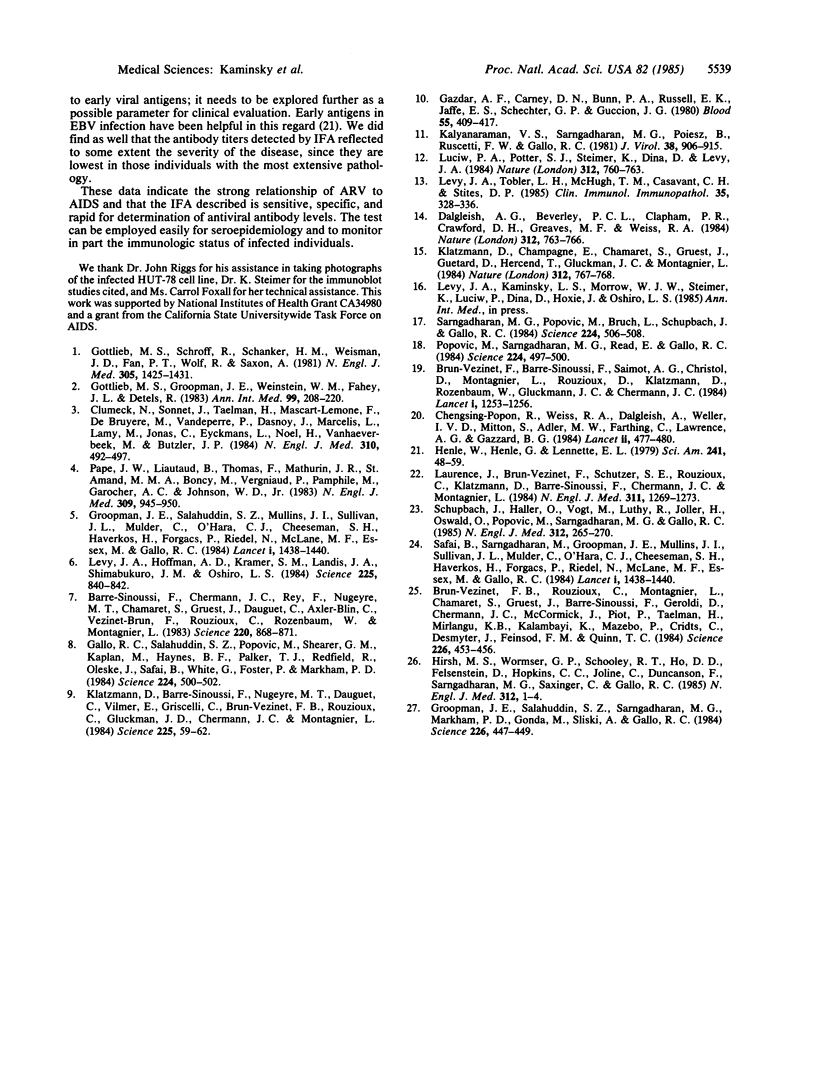
Images in this article
Selected References
These references are in PubMed. This may not be the complete list of references from this article.
- Barré-Sinoussi F., Chermann J. C., Rey F., Nugeyre M. T., Chamaret S., Gruest J., Dauguet C., Axler-Blin C., Vézinet-Brun F., Rouzioux C. Isolation of a T-lymphotropic retrovirus from a patient at risk for acquired immune deficiency syndrome (AIDS). Science. 1983 May 20;220(4599):868–871. doi: 10.1126/science.6189183. [DOI] [PubMed] [Google Scholar]
- Brun-Vezinet F., Rouzioux C., Barre-Sinoussi F., Klatzmann D., Saimot A. G., Rozenbaum W., Christol D., Gluckmann J. C., Montagnier L., Chermann J. C. Detection of IgG antibodies to lymphadenopathy-associated virus in patients with AIDS or lymphadenopathy syndrome. Lancet. 1984 Jun 9;1(8389):1253–1256. doi: 10.1016/s0140-6736(84)92444-9. [DOI] [PubMed] [Google Scholar]
- Brun-Vézinet F., Rouzioux C., Montagnier L., Chamaret S., Gruest J., Barré-Sinoussi F., Geroldi D., Chermann J. C., McCormick J., Mitchell S. Prevalence of antibodies to lymphadenopathy-associated retrovirus in African patients with AIDS. Science. 1984 Oct 26;226(4673):453–456. doi: 10.1126/science.6238406. [DOI] [PubMed] [Google Scholar]
- Clumeck N., Sonnet J., Taelman H., Mascart-Lemone F., De Bruyere M., Vandeperre P., Dasnoy J., Marcelis L., Lamy M., Jonas C. Acquired immunodeficiency syndrome in African patients. N Engl J Med. 1984 Feb 23;310(8):492–497. doi: 10.1056/NEJM198402233100804. [DOI] [PubMed] [Google Scholar]
- Dalgleish A. G., Beverley P. C., Clapham P. R., Crawford D. H., Greaves M. F., Weiss R. A. The CD4 (T4) antigen is an essential component of the receptor for the AIDS retrovirus. Nature. 1984 Dec 20;312(5996):763–767. doi: 10.1038/312763a0. [DOI] [PubMed] [Google Scholar]
- Gallo R. C., Salahuddin S. Z., Popovic M., Shearer G. M., Kaplan M., Haynes B. F., Palker T. J., Redfield R., Oleske J., Safai B. Frequent detection and isolation of cytopathic retroviruses (HTLV-III) from patients with AIDS and at risk for AIDS. Science. 1984 May 4;224(4648):500–503. doi: 10.1126/science.6200936. [DOI] [PubMed] [Google Scholar]
- Gazdar A. F., Carney D. N., Bunn P. A., Russell E. K., Jaffe E. S., Schechter G. P., Guccion J. G. Mitogen requirements for the in vitro propagation of cutaneous T-cell lymphomas. Blood. 1980 Mar;55(3):409–417. [PubMed] [Google Scholar]
- Gazzard B. G., Shanson D. C., Farthing C., Lawrence A. G., Tedder R. S., Cheingsong-Popov R., Dalgleish A., Weiss R. A. Clinical findings and serological evidence of HTLV-III infection in homosexual contacts of patients with AIDS and persistent generalised lymphadenopathy in London. Lancet. 1984 Sep 1;2(8401):480–483. doi: 10.1016/s0140-6736(84)92563-7. [DOI] [PubMed] [Google Scholar]
- Gottlieb M. S., Groopman J. E., Weinstein W. M., Fahey J. L., Detels R. The acquired immunodeficiency syndrome. Ann Intern Med. 1983 Aug;99(2):208–220. doi: 10.7326/0003-4819-99-2-208. [DOI] [PubMed] [Google Scholar]
- Gottlieb M. S., Schroff R., Schanker H. M., Weisman J. D., Fan P. T., Wolf R. A., Saxon A. Pneumocystis carinii pneumonia and mucosal candidiasis in previously healthy homosexual men: evidence of a new acquired cellular immunodeficiency. N Engl J Med. 1981 Dec 10;305(24):1425–1431. doi: 10.1056/NEJM198112103052401. [DOI] [PubMed] [Google Scholar]
- Groopman J. E., Salahuddin S. Z., Sarngadharan M. G., Markham P. D., Gonda M., Sliski A., Gallo R. C. HTLV-III in saliva of people with AIDS-related complex and healthy homosexual men at risk for AIDS. Science. 1984 Oct 26;226(4673):447–449. doi: 10.1126/science.6093247. [DOI] [PubMed] [Google Scholar]
- Henle W., Henle G., Lennette E. T. The Epstein-Barr virus. Sci Am. 1979 Jul;241(1):48–59. doi: 10.1038/scientificamerican0779-48. [DOI] [PubMed] [Google Scholar]
- Hirsch M. S., Wormser G. P., Schooley R. T., Ho D. D., Felsenstein D., Hopkins C. C., Joline C., Duncanson F., Sarngadharan M. G., Saxinger C. Risk of nosocomial infection with human T-cell lymphotropic virus III (HTLV-III). N Engl J Med. 1985 Jan 3;312(1):1–4. doi: 10.1056/NEJM198501033120101. [DOI] [PubMed] [Google Scholar]
- Kalyanaraman V. S., Sarngadharan M. G., Poiesz B., Ruscetti F. W., Gallo R. C. Immunological properties of a type C retrovirus isolated from cultured human T-lymphoma cells and comparison to other mammalian retroviruses. J Virol. 1981 Jun;38(3):906–915. doi: 10.1128/jvi.38.3.906-915.1981. [DOI] [PMC free article] [PubMed] [Google Scholar]
- Klatzmann D., Barré-Sinoussi F., Nugeyre M. T., Danquet C., Vilmer E., Griscelli C., Brun-Veziret F., Rouzioux C., Gluckman J. C., Chermann J. C. Selective tropism of lymphadenopathy associated virus (LAV) for helper-inducer T lymphocytes. Science. 1984 Jul 6;225(4657):59–63. doi: 10.1126/science.6328660. [DOI] [PubMed] [Google Scholar]
- Klatzmann D., Champagne E., Chamaret S., Gruest J., Guetard D., Hercend T., Gluckman J. C., Montagnier L. T-lymphocyte T4 molecule behaves as the receptor for human retrovirus LAV. Nature. 1984 Dec 20;312(5996):767–768. doi: 10.1038/312767a0. [DOI] [PubMed] [Google Scholar]
- Laurence J., Brun-Vezinet F., Schutzer S. E., Rouzioux C., Klatzmann D., Barré-Sinoussi F., Chermann J. C., Montagnier L. Lymphadenopathy-associated viral antibody in AIDS. Immune correlations and definition of a carrier state. N Engl J Med. 1984 Nov 15;311(20):1269–1273. doi: 10.1056/NEJM198411153112001. [DOI] [PubMed] [Google Scholar]
- Levy J. A., Hoffman A. D., Kramer S. M., Landis J. A., Shimabukuro J. M., Oshiro L. S. Isolation of lymphocytopathic retroviruses from San Francisco patients with AIDS. Science. 1984 Aug 24;225(4664):840–842. doi: 10.1126/science.6206563. [DOI] [PubMed] [Google Scholar]
- Levy J. A., Tobler L. H., McHugh T. M., Casavant C. H., Stites D. P. Long-term cultivation of T-cell subsets from patients with acquired immune deficiency syndrome. Clin Immunol Immunopathol. 1985 Jun;35(3):328–336. doi: 10.1016/0090-1229(85)90093-5. [DOI] [PubMed] [Google Scholar]
- Luciw P. A., Potter S. J., Steimer K., Dina D., Levy J. A. Molecular cloning of AIDS-associated retrovirus. Nature. 1984 Dec 20;312(5996):760–763. doi: 10.1038/312760a0. [DOI] [PubMed] [Google Scholar]
- Pape J. W., Liautaud B., Thomas F., Mathurin J. R., St Amand M. M., Boncy M., Pean V., Pamphile M., Laroche A. C., Johnson W. D., Jr Characteristics of the acquired immunodeficiency syndrome (AIDS) in Haiti. N Engl J Med. 1983 Oct 20;309(16):945–950. doi: 10.1056/NEJM198310203091603. [DOI] [PubMed] [Google Scholar]
- Popovic M., Sarngadharan M. G., Read E., Gallo R. C. Detection, isolation, and continuous production of cytopathic retroviruses (HTLV-III) from patients with AIDS and pre-AIDS. Science. 1984 May 4;224(4648):497–500. doi: 10.1126/science.6200935. [DOI] [PubMed] [Google Scholar]
- Safai B., Sarngadharan M. G., Groopman J. E., Arnett K., Popovic M., Sliski A., Schüpbach J., Gallo R. C. Seroepidemiological studies of human T-lymphotropic retrovirus type III in acquired immunodeficiency syndrome. Lancet. 1984 Jun 30;1(8392):1438–1440. doi: 10.1016/s0140-6736(84)91933-0. [DOI] [PubMed] [Google Scholar]
- Safai B., Sarngadharan M. G., Groopman J. E., Arnett K., Popovic M., Sliski A., Schüpbach J., Gallo R. C. Seroepidemiological studies of human T-lymphotropic retrovirus type III in acquired immunodeficiency syndrome. Lancet. 1984 Jun 30;1(8392):1438–1440. doi: 10.1016/s0140-6736(84)91933-0. [DOI] [PubMed] [Google Scholar]
- Sarngadharan M. G., Popovic M., Bruch L., Schüpbach J., Gallo R. C. Antibodies reactive with human T-lymphotropic retroviruses (HTLV-III) in the serum of patients with AIDS. Science. 1984 May 4;224(4648):506–508. doi: 10.1126/science.6324345. [DOI] [PubMed] [Google Scholar]
- Schüpbach J., Haller O., Vogt M., Lüthy R., Joller H., Oelz O., Popovic M., Sarngadharan M. G., Gallo R. C. Antibodies to HTLV-III in Swiss patients with AIDS and pre-AIDS and in groups at risk for AIDS. N Engl J Med. 1985 Jan 31;312(5):265–270. doi: 10.1056/NEJM198501313120502. [DOI] [PubMed] [Google Scholar]



